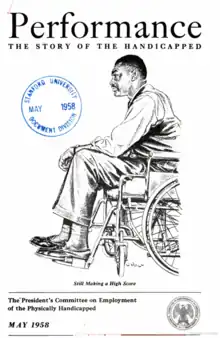Junius Kellogg
Junius Kellogg (March 16, 1927 – September 16, 1998) was an American basketball player, coach, and civil servant. He was the first African-American to play basketball for Manhattan College. While playing for the Jaspers, Kellogg became known for his role in helping to expose the CCNY point-shaving scandal of 1950–51.
Junius Kellogg | |
|---|---|
 Junius Kellogg on the cover of the federal publication Performance (May 1958) | |
| Born | March 16, 1927 Portsmouth, Virginia |
| Died | September 16, 1998 Bronx, New York |
| Occupation(s) | Basketball player, coach |
Early life
Kellogg was from Portsmouth, Virginia,[1] the eldest of the twelve children of Theodore Kellogg and Lucy Kellogg.[2][3] He graduated from Norcom High School.[1]
College career
In 1951, Kellogg, a standout 6'8" center, was offered a $1,000 bribe to shave points, before a game against DePaul.[4] Although he was working for minimum wage at a frozen custard shop near campus, he refused to take it, reporting the solicitation to his coach, Ken Norton. Norton sent him to the district attorney, Frank Hogan. To get evidence about the corruption, he wore a wire when he was again approached in a nearby bar. His whistle blowing touched off the largest college betting scandal in American history.[3] Ultimately, the investigation involved thirty-two players from seven colleges and encompassed 86 games between 1947 and 1950, including three stars from the 1950 City College of New York team. CCNY had won both the National Invitation Tournament and the NCAA Division I men's basketball tournament, in 1950, the only time that has ever been accomplished.[5]
Car accident and later life
Kellogg left college for a stint in the Army, serving in Korea. He then returned to Manhattan College, where he doubled up on courses. He graduated in 1953 and began playing for the Harlem Globetrotters. In 1954, he sustained a cervical spinal cord injury in an automobile accident and was paralyzed. Three fellow Globetrotters were unscathed during the accident.[6]
Kellogg received treatment at the Veterans Administration Hospital in the Bronx, New York City, New York. He became an ardent supporter of wheelchair athletics.[7] He coached the Pan Am Jets as well as the Brooklyn Whirlaways.[8] He was head coach of the USA Stoke Mandeville Games team as well as the head coach of the 1964 US Paralympic Basketball Team where the USA team won the gold medal. He was inducted into the National Wheelchair Basketball Association's hall of fame in 1981.[9] In 2000, Kellogg was inducted into the Virginia Sports Hall of Fame.
Kellogg served for many years on the board of directors of Eastern Paralyzed Veterans Association (later the United Spinal Association) and worked for New York City from 1966 until his death in 1998. He served at the first deputy commissioner and director of strategic planning for the Community Development Agency. He received an honorary Doctor of Laws degree from Manhattan College in 1997.[3]
Personal life and legacy
Kellogg married a social worker, Clementine Riggsbee, in 1959.[10] He died in 1998, at the age of 71, at the Bronx VA Medical Center.[11] In 1999, a New York City youth gymnasium was named for Kellogg.[12]
References
- Rodgers, Lee F. (1954-08-30). "Colored Notes". The Portsmouth Star. p. 37. Retrieved 2023-05-01 – via Newspapers.com.
- Jackson, Warren (1974-06-17). "A good guy's not forgotten". The Standard-Star. p. 13. Retrieved 2023-05-01 – via Newspapers.com.
- Litsky, Frank (1998-09-18). "Junius Kellogg Is Dead at 71; Refused Bribe in 50's Scandal". The New York Times. ISSN 0362-4331. Retrieved 2023-05-02.
- Lipper, Bob (February 28, 2003). "Junius Kellogg". Richmond Times-Dispatch. Retrieved 2023-05-02.
- Junius Kellogg is dead at 71 Refused bribe in '50s scandal, New York Times, Frank Litsky, September 18, 1998. Retrieved 2 February 2017.
- Topol, Manny (1998-09-18). "Junius Kellogg, 71, Revealed College Basketball Scandal". Newsday (Nassau Edition). p. 75. Retrieved 2023-05-02 – via Newspapers.com.
- "Famous Negro Athlete Conquers Paralysis, Now Cheers Others". Performance: The Story of the Handicapped. 8 (11): 6, 13. May 1958.
- Wolk, Bruce. "The Man Who Saved Basketball: Junius A. Kellogg and the Pan Am Jets". Pan Am Jets. Retrieved 2023-05-02.
- Hall of Fame profile at the National Wheelchair Basketball Association
- Armstrong, R. D. (1959-04-26). "News About Negroes". Rocky Mount Telegram. p. 40. Retrieved 2023-05-02 – via Newspapers.com.
- Bondy, Filip (1998-09-18). "New York Loses True Sports Hero". Daily News. p. 1129. Retrieved 2023-05-02 – via Newspapers.com.
- "Mayor Giuliani Dedicates DYCD Auditorium to the Memory of Junius Kellogg". Archives of the Mayor's Press Office. March 29, 1999. Retrieved May 1, 2023.